Indonesian Traditions to Expand Your Cultural Awareness
Indonesia’s cultural diversity is influenced by the thousands of islands and the 1,300 ethnic groups that make up the Asian nation. While each group has their own unique set of customs, they all place great importance on maintaining strong family ties.
Children don’t typically move out of their parents’ homes when they’re grown, and it’s not uncommon for grandparents, uncles, and other extended family to live together in the same house or neighborhood.
Even outside the family unit, Indonesians are communal. Villages have close-knit communities that look out for each other, and farmers operate collectively to manage resources and cultivate their lands.
Religion
Religion is also central to daily life. Despite having the largest Muslim population in the world, Indonesia has six official religions — Islam, Catholicism, Hinduism, Buddhism, Protestantism and Confucianism.
Additionally, millions of people practice one of 180 traditional belief systems, which uphold their ancestors’ religious practices and have roots in dynamism and animism. Some Indonesians mix those beliefs with traditions from mainstream religions, creating their own unique customs.
Traditions and rituals
Given the importance of spirituality in Indonesian culture, it’s not surprising that many traditions, rituals, and cultural values are reflected in contemporary life. For example, companies may consult a spiritual elder to determine the best day to do business. When couples marry, many choose to have traditional wedding ceremonies.
And weddings aren’t the only traditional celebrations Indonesians take part in to mark important life events: Milestones like first steps have special ceremonies associated with them, as do communal celebrations like the harvest or dates associated with certain legends. Locals share those folk tales to explain how gods and spirits contributed to the creation of natural, religious, or cultural landmarks.
Indonesian dances
These cultural influences have also contributed to a thriving arts scene, from music to the visual arts to dance.
Traditional Indonesian dances reflect the unique values of the country’s ethnic groups. One of the most well-known is the Saman dance that originated in the province of Aceh and uses hand clapping and shoulder clapping to make percussion sounds. The art form incorporates many values of the Acehnese people — wisdom, manners, faith, and heroism.
Dating back to the 12th century, the Serimpi dance is accompanied by traditional Javanese gamelan music. An elegant and graceful dance, it’s performed by four or five women who use stylized hand positions and slow movements to demonstrate modesty, finesse, and beauty.
The island of Bali is also known for its many traditional dances, like Wali, Bebali, and Barong, which incorporate ancient Hindu traditions with drama and involve graceful hand, leg, and finger movements, and even some martial arts techniques.
